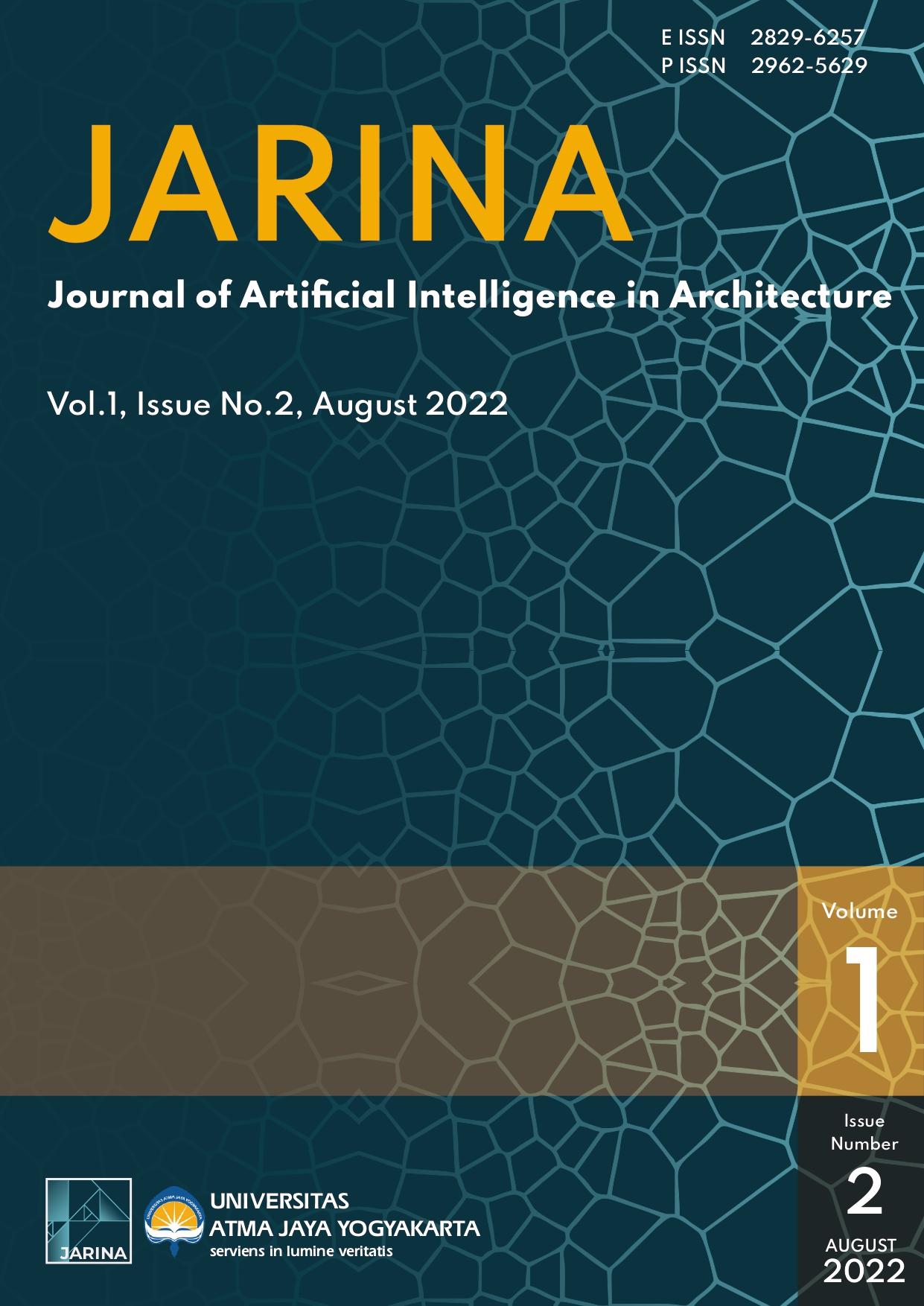Function, Role, Limitation, and Potential of Space Syntax Analysis in Architectural Field
DOI:
https://doi.org/10.24002/jarina.v1i2.6093Keywords:
Space Syntax , Function, Role, Limitation, PotentialAbstract
This study aims to determine the function, roles, limitations, and potential of spatial configuration analysis with Space Syntax. The development of digital technology affects the development of science, including in the field of architecture. Digital technology is not only a design visualization tool but also a part of the design process and a thinking tool for architects in designing. One of them is the Space Syntax program. Space Syntax is a quantitative analysis tool used to analyze the pattern of relationships between spaces in various forms of architectural space: buildings, cities, interiors, and landscapes. The method used in this research is the literature study method. Data collection techniques are collecting several sources from the internet and journal references that discuss using the Space Syntax program. The results of this study indicate that Space Syntax has a function, roles, limitations, and potential in analyzing architectural space. SpaceSyntax can explore various horizontal space scales, including buildings objects and urban areas. However, the findings show that Space Syntax has limitations. Some studies use a combination of other methods to overcome this limitation. The combination method also raises the potential of Space Syntax as an analysis tool in the architectural field.
References
M. G. Gunagama dan N. F. Lathifa, “Automatictecture : Otomatisasi Penuh Dalam Arsitektur Masa Depan,” NALARs, vol. 16, no. 1, pp. 43, 2017.
D. Nurhalimah dan D. W. Astuti, “Analisis Hubungan Konfigurasi Ruang dengan Penyebaran Pengunjung Pasar Klewer Menggunakan Space Syntax ,” Sinektika J. Arsit., vol. 17, no. 1, pp. 13–20, 2020.
B. Hillier, Space is the machine: a configurational theory of architecture. Space Syntax, 2007.
S. Bafna, “Space Syntax: A brief introduction to its logic and analytical techniques,” Environ. Behav., vol. 35, no. 1, pp. 17–29, 2003.
W. C. Yudhanta, “Pengaruh Konfigurasi Dan Visibilitas Ruang Pada Aksesibilitas, Studi Kasus Pada Kawasan Xt Square Yogyakarta,” J. Arsit. KOMPOSISI, vol. 12, no. 1, pp. 67, 2018.
R. A. Halid, “HUBUNGAN POLA GUNA RUANG DENGAN KONFIGURASI RUANG DI ALUN-ALUN UTARA YOGYAKARTA Menggunakan metode analisa Space Syntax ,” Universitas Gadjah Mada, 2012.
J. Adiyanto, “Kajian Perubahan Ruang Terbuka pada Kawasan Bersejarah dengan Metode Space Syntax (Studi kasus Kawasan Kampung Kapitan Palembang),” J. Perenc. Wil. dan Kota, vol. 27, no. 2, pp. 103, 2016.
M. F. Romdhoni, “Analisis Pola Konfigurasi Ruang Terbuka Kota Dengan Penggunaan Metoda Space Syntax Sebagai Spatial Logic Dan Space Use,” NALARs, vol. 17, no. 2, pp. 113, 2018.
M. Karmilah dan N. S. Magfiroh, “Using Space Syntax To Determine The Form And Pattern Of Heritage Site (Case Study: Sangiran Heritage Site),” J. Planol., vol. 15, no. 1, pp. 81, 2018.
T. Ramadhan, G. Ramadhan, K. Wijaya, dan A. Y. Permana, “Kajian Spasial Penempatan Fasilitas Sosial di Pemukiman Padat Kota Bandung: Analisis Space Syntax Studi Kasus : Wilayah Kelurahan Burangrang, Kecamatan Lengkong, Kota Bandung,” J. Arsit. ARCADE, vol. 2, no. 2, pp. 66, 2018.
A. L. Liem, “Analisis Konfigurasi Tapak Ruang Permukiman Kampung Kota Berbasis Space Syntax ( Studi Kasus : Perumahan Padat Penduduk Kelurahan Sindulang Satu , Manado ),” J. Malige Arsit., vol. 1, no. 2, pp. 11–20, 2019.
M. Isabela, “INTERKONEKTIVITAS RUANG PUBLIK SEBAGAI PENINGKAT KUALITAS KAWASAN PEMUKIMAN TEPIAN SUNGAI GAJAH WONG, MENGGUNAKAN SPACE SYNTAX ,” Universitas Gadjah Mada, 2013.
W. P. Barada dan D. Mutiari, “Analisis Space Syntax Rumah Susun Berbasis Gang Kampung,” Simp. Nas. RAPI XII, pp. 59–63, 2013.
H. S. Bayu Setyanugraha Rushadi, Tito Haripradianto, “Sekolah Fotografi di Kota Malang Dengan Pendekatan Analisa Space Syntax ,” Jurnal, 2016.
M. E. Wijaya, “Revitalisasi Pasar Blauran Surabaya Dengan Pendekatan Analisis Space Syntax .” Universitas Brawijaya, 2018.
I. Irwanuddin, “Identifikasi Genotype Rumah Adat Sumba Barat dengan Metode Space Syntax ,” J. RUAS, vol. 16, no. 1, pp. 58–70, 2018.
R. Hadiwibowo, “Penataan Elemen Sirkulasi Vertikal Pada Gedung Unpar Jl.Merdeka No.30 Bandung Melalui Pendekatan Space Syntax Dan Kriteria Heritage,” 2019.
A. A. P. Putra dan A. Nareswari, “Space Consolidation for Fishing Settlement in Mariso District, Makassar City with Space Syntax,” J. Archit. Res. Des. Stud., vol. 2, no. 2, 2019.
A. Y. Permana, A. F. S. Permana, dan D. Andriyana, “Konfigurasi Ruang Berdasarkan Kualitas Konektivitas Ruangan Dalam Perancangan Kantor: Space Syntax Analysis,” J. Arsit. Zo., vol. 3, no. 2, pp. 155–170, 2020.
W. A. Lily Mauliani, Anisa, “Permeabilitas Blok Perkantoran Jl.MH. Thamrin Untuk Akses Stasiun MRT Bundaran HI Jakarta Menggunakan Space,” Univ. Muhammadiyah Jakarta, vol. 38, no. 4, pp. 7–17, 2018.
E. Valipour, S. Tayyebisoudkolaei, dan A. Mobaraki, “Establishment of Space Syntax to read urban road network; the case of Sari, Iran,” J. Contemp. Urban Aff., vol. 1, no. 2, pp. 69–75, 2017.
E. Valipour, A. Mobaraki, M. Nikoofam, dan S. Tayyebisoudkolaei, “Establishment of Space Syntax to read and analyze urban network; the case of study, Famagusta city of Cyprus,” J. Contemp. Urban Aff., vol. 3, no. 1, pp. 154–160, 2019.
W. Aqli, “Space Syntax Analysis On Level Of Security And Privacy Of Road Space. Case Study: Campus Area Of Universitas Gadjah Mada, Yogyakarta,” Int. J. Built Environ. Sci. Res., vol. 3, no. 1, pp. 39, 2019.
M. F. Arief, T. S. Pitana, dan U. J. Cahyono, “Spatial transformation in Klego Simo Corridor, Boyolali,” IOP Conf. Ser. Earth Environ. Sci., vol. 871, no. 1, 2021.
A. Prihatiningrum, “Desain konfigurasi bangunan dan hubungannya dengan aktivitas akademik dalam upaya mitigasi bencana,” Civ. Eng. Built Environ. Conf. 2019, pp. 62–71, 2019.
V. Cutini dan C. Pezzica, “Street network resilience put to test: The dramatic crash of Genoa and Bologna bridges,” Sustain., vol. 12, no. 11, 2020.
R. H. M. Pereira, F. R. B. De Holanda, V. A. S. De Medeiros, dan A. P. B. G. Barros, “THE USE OF SPACE SYNTAX IN URBAN TRANSPORT ANALYSIS: limits and potentials,” Inst. Appl. Econ. Res., no. 188, pp. 1–25, 2015.
C. Yamu, A. van Nes, dan C. Garau, “Bill Hillier’s legacy: Space Syntax —a synopsis of basic concepts, measures, and empirical application,” Sustain., vol. 13, no. 6, 2021.
W. Dettlaff, “Space Syntax analysis-methodology of understanding the space,” Ph.D. Interdiscip. J., pp. 283–
, 2014.
Á. Clua, J. Llorca-Bofí, dan S. Psarra, “Urban opportunities and conflicts around street musicians: the relationship between the configuration of public space and outdoor acoustics in Ciutat Vella, Barcelona,” J. Urban Des., vol. 25, no. 5, pp. 561–589, 2020.
C. Atakara dan M. Allahmoradi, “Investigating the urban spatial growth by using Space Syntax and gis—a case study of Famagusta city,” ISPRS Int. J. Geo-Information, vol. 10, no. 10, 2021.
Published
How to Cite
Issue
Section
License
Copyright (c) 2022 Fitria Khairanisa

This work is licensed under a Creative Commons Attribution 4.0 International License.
Authors who publish with this journal agree to the following terms:
1.Authors retain copyright and grant the journal right of first publication with the work simultaneously licensed under a Creative Commons that allows others to share the work with an acknowledgement of the work's authorship and initial publication in this journal.
2.Authors are able to enter into separate, additional contractual arrangements for the non-exclusive distribution of the journal's published version of the work (e.g., post it to an institutional repository or publish it in a book), with an acknowledgement of its initial publication in this journal.
3.Authors are permitted and encouraged to post their work online (e.g., in institutional repositories or on their website) prior to and during the submission process, as it can lead to productive exchanges, as well as earlier and greater citation of published work (See The Effect of Open Access).

















